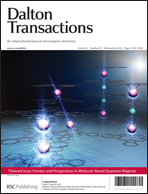We herein present the synthesis and magneto-structural study of a new family of heterobimetallic chains of general formula {[FeIII(dmbpy)(CN)4]2MII(H2O)2}n·pnH2O [dmbpy = 4,4′-dimethyl-2,2′-bipyridine; M = Mn (2), Cu (3), Ni (4) and Co (5) with p = 4 (2), 3 (3), 9 (4) and 3.5 (5)] which were prepared by using the mononuclear PPh4[FeIII(dmbpy)(CN)4]·3H2O (1) building block (PPh4+ = tetraphenylphosphonium) as a ligand toward fully solvated MII ions. The structure of 1 consists of discrete [FeIII(dmbpy)(CN)4]− anions, tetraphenylphosphonium cations and noncoordinated water molecules. Complexes 2–5 are isostructural compounds whose structure consists of neutral 4,2-wave like heterobimetallic chains of formula {[FeIII(dmbpy)(CN)4]2MII(H2O)2}n where the [FeIII(dmbpy)(CN)4]− entity adopts a bis-monodentate coordination mode toward trans-[MII(H2O)2] units through two of its four cyanide groups in cis positions. 1 exhibits the magnetic behaviour of magnetically isolated six-coordinate low-spin Fe(III) complexes with an important orbital contribution. 2 behaves as ferrimagnetic FeIII2MnII chains, whereas 3–5 exhibit intrachain ferromagnetic couplings between the low-spin Fe(III) and either Cu(II) (3), Ni (4) or Co(II) (5) as well as frequency-dependence of the out-of-phase ac susceptibility signals below 3.0 (3), 5.5 (4) and 5.0 K (5). The relaxation time and the energy to reverse the magnetization of 3–5 are related to the anisotropy of the M(II) center and to the intra- and interchain magnetic interactions. Unprecedentedly in the world of cyanide-bearing complexes, 5 exhibits a double slow relaxation of the magnetization.
![Graphical abstract: [FeIII(dmbpy)(CN)4]−: a new building block for designing single-chain magnets](/en/Image/Get?imageInfo.ImageType=GA&imageInfo.ImageIdentifier.ManuscriptID=C2DT31675G&imageInfo.ImageIdentifier.Year=2012)
You have access to this article
 Please wait while we load your content...
Something went wrong. Try again?
Please wait while we load your content...
Something went wrong. Try again?
![Graphical abstract: [FeIII(dmbpy)(CN)4]−: a new building block for designing single-chain magnets](/en/Image/Get?imageInfo.ImageType=GA&imageInfo.ImageIdentifier.ManuscriptID=C2DT31675G&imageInfo.ImageIdentifier.Year=2012)

 Please wait while we load your content...
Please wait while we load your content...